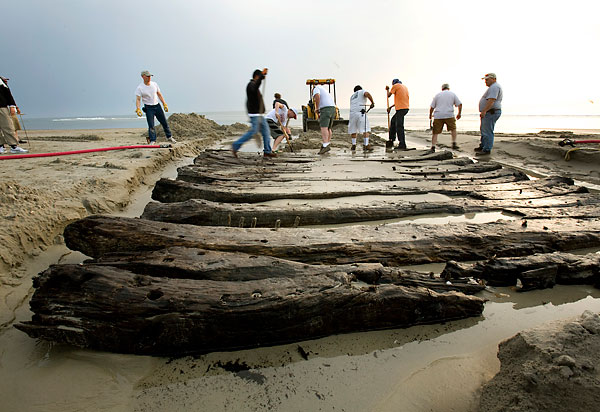
Crew works to save oldest-known shipwreck on N.C. coast
By Jeff HamptonThe Virginian-Pilot
© April 7, 2010
COROLLA , N.C.
As Tuesday's sun edged over the Atlantic horizon, 25 volunteers frantically dug sand from what may be the oldest known shipwreck on the Outer Banks.
This was a race against the tide to excavate the 12-ton remains of a shipwreck more than 300 years old. The ship is one of dozens along the coast visible in the surf or just offshore. It's among some 5,000 recorded wrecks along what is known as the Graveyard of the Atlantic.
But this wreck of hand-hewn beams fastened entirely with wooden pegs could be the oldest of them all.
"We just don't find ships of this age in this good shape," said Richard Lawrence, director of the North Carolina Underwater Archaeology Branch. "This is unique."
A November storm fully exposed the timbers, attracting archaeologists to document and research it. In the following weeks, strong currents lifted the wreck and carried it south two miles. As it moved, planks were lost and a large piece of the keel disappeared. In the past two weeks, the wreck moved back north about a mile.
Typically, shipwrecks stay where they lie, getting exposed occasionally, then disappearing again under the sand. The old ship had probably remained in the same spot since the late 1600s until the winter storms, Lawrence said.
But this one was mobile, and it could fall apart and be lost.
Dare County residents Ray Midgett and Roger Harris, avid beachcombers, explored the wreck when it was on the beach near the lighthouse. Harris first spotted part of the beams jutting from the sand in the mid-1990s.
They found coins from the early 1600s marked with King Louis XIII and King Charles I, Harris said. Midgett found a coin stamped with 1603.
Midgett wrote letters in March in an effort to save the ship, and state Sen. Marc Basnight, D-Dare, asked the state Wildlife Resources Commission to help.
After 45 minutes of digging, the tops of the beams were exposed. A fire truck from Corolla washed more sand from between and under the timbers.
The plan was to use air bags and the hydraulic tool used to extricate victims from wrecks to lift the timbers. A backhoe and a front-end loader with a telescoping hydraulic arm would lift and pull the wreck out of its hole and down the beach.
"It's kind of cool," said Jeff Foster, assistant chief of Corolla Fire and Rescue. "This is a blend of an ancient shipwreck and modern technology. Whether it will work or not, the jury is out."
By 8 a.m., the observing crowd had grown to about 50. Nearly an hour later, one side had been lifted, and the first large beam of the sled was under one side. By then, the crowd had grown to about 100, with many vacationers.
At 9:20, with the tide approaching and the sun getting higher and hotter, another beam was slid under the other side of the wreck.
Within a few minutes, heavy equipment operators with the Wildlife Resources Commission attached a cross member to the two beams and finished the sled. But after a strong pull and with the engine revving, even the large, ribbed tires of the machine began to sink.
Twenty-five minutes later, the crew stood on the beach for a conference while the crowd waited. One person suggested, "Put a fence around it and leave it where it is."
But the crew members tried another tactic: They attached the sled to the extended telescoping arm and retracted it. The back tires lifted off the ground a little, then alighted again. Gradually, the dark, waterlogged timbers, 20 feet by about 16 feet, moved over the sand, as t he crowd cheered.
Soon the wreckage would be crossing N.C. 12 to a spot near the lighthouse.
"We'll document every fastener and hole on this thing and try to extrapolate what this ship looked like," Lawrence said.
Archaeologists believe this could be the HMS Swift, a British ship about 70 feet long and 16 feet wide that ran aground off Point Comfort in the Chesapeake Bay in 1698.
The crew abandoned the ship, according to an account in the North Carolina Historical Review by Samuel Margolin.
The current carried the Swift southward, where it beached on the Currituck County Outer Banks. Residents, known as "bankers," scuttled the ship, cutting a hole in the bottom to make sure it didn't float away.
A rough hole of about 6 inches by 3 inches is visible today in the hull planks. That hole, scientists believe, is the one cut by the bankers to scuttle the Swift, said Nathan Henry, an underwater archaeologist.
The British sent officials down to reclaim the ship and prosecute those who had plundered it. Nine were arrested, including Capt. Anthony Dawson, who was the leader. Six were found not guilty. Dawson's sentence of hanging was commuted to exile from the colony.
One man was branded with a "T" - for thief - on his left thumb and given 30 lashes, according to Margolin's account. British authorities were angered at the North Carolina leniency for most of the defendants.
"They had political connections," Harris said. "Nothing's changed."
By noon Tuesday, the old ship's skeleton rested under a large oak tree.
"I'm delighted," Midgett said. "I don't think this could have gone any better."
Jeff Hampton, (252) 338-0159, jeff.hampton@pilotonline.com